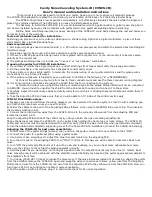
SmartDGA Hardware Manual
Valve Installation
•
25
4
Valve Installation
Once complete with Pre-Installation Verification, proceed with installation of the SmartDGA
®
system. Recommended installation order is installing the valve kits, then the instruments, followed
by the EZHub and computer/
i
Core. There are three types of valve installations. Follow instruction for
the valve kit and configuration you are using:
•
For Single Valve (VA-1) installation instructions, see section 4.1.
•
For Dual Valve (VA-2) installation instructions, see section 4.2.
•
For Off-Transformer/Inline (VA-0) installation instructions, see section 4.3.
Note:
To avoid leaks, tape, grease, and tighten. Use tape and grease on all NPT threads
throughout the installation process. Starting from the bottom, wrap the tape in the
opposite direction as the threads so that when connecting, the tape is not torn off. Once
taped, apply enough grease to cover the threads. Then connect and tighten.
Tightening Swagelok Fittings
Many of the provided connectors are Swagelok
®
fittings. Follow these steps to ensure a
proper fit:
1.
Insert the tube into the fitting as far as it will go and rotate the nut until it is
hand tight.
2.
Mark the nut at the 6 o’clock position. Hold the fitting body steady with a second
wrench and tighten the marked nut 1.25 turns to the 9 o’clock position.
As you assemble and attach the valve kits, tighten as you go, but be careful not to
overtighten. Overtightening can cause the part to distort and not properly seal when
retightened.
Visit Swagelok’s website for more information on tightening fittings (page 62):
http://www.swagelok.com/downloads/WebCatalogs/en/MS-01-140.PDF
Warning:
All oil wetted metal components of the SmartDGA system are made of 316
stainless steel to avoid corrosion and interaction with dissolved gases. SmartDGA
performance and reliability are only guaranteed when all oil wetted connections use 316
stainless steel, including any customer supplied tubing or adapter components for the
following reasons:
•
Components other than stainless steel will likely experience accelerated corrosion.
Different metals in direct contact with each other will undergo galvanic corrosion
even under mild ambient conditions.
•
Copper and copper containing alloys react with dissolved gases such as acetylene to
form unstable potentially explosive compounds and reduce the apparent
concentration of analyte gases.
•
Galvanized components can release hydrogen and cause false readings.
•
Copper tubing is soft and does not form a reliable long term seal.
•
Polymer based flexible hoses are gas permeable and allow ambient oxygen into the
oil and dissolved gases to escape. Use stainless steel lined flexible hoses such as
Swagelok FL hoses. Tubing should have an appropriate inner diameter for flow
while maintain enough wall thickness for strength for 1/4" OD tubing the wall
thickness should be 0.035”.
Summary of Contents for SmartDGA
Page 1: ...HARDWARE MANUAL SmartDGA...
Page 99: ...SmartDGA Hardware Manual Diagrams Drawings 99 9 5 SmartDGA NEMA 4 Enclosure...
Page 100: ...SmartDGA Hardware Manual Diagrams Drawings 100 9 6 Inline Mounting Plate...
Page 102: ...SmartDGA Hardware Manual Diagrams Drawings 102 9 8 Assy Wall Mount SmartDGA EZHubTM...
Page 103: ...SmartDGA Hardware Manual Diagrams Drawings 103...
Page 104: ...SmartDGA Hardware Manual Diagrams Drawings 104 9 9 Assy Panel Mount SmartDGA EZHubTM...
Page 105: ...SmartDGA Hardware Manual Diagrams Drawings 105...
Page 106: ...SmartDGA Hardware Manual Diagrams Drawings 106 9 10 Assy Wall Mount LumaSMART iCoreTM...
Page 107: ...SmartDGA Hardware Manual Diagrams Drawings 107...
Page 108: ...SmartDGA Hardware Manual Diagrams Drawings 108 9 11 Assy Panel Mount LumaSMART iCoreTM...
Page 109: ...SmartDGA Hardware Manual Diagrams Drawings 109...
Page 110: ...SmartDGA Hardware Manual Diagrams Drawings 110 9 12 SmartDGA Instrument Sun Shade...
Page 111: ...SmartDGA Hardware Manual Diagrams Drawings 111...
















































